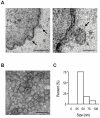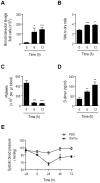Outer membrane vesicles derived from Escherichia coli induce systemic inflammatory response syndrome
- PMID: 20596524
- PMCID: PMC2893157
- DOI: 10.1371/journal.pone.0011334
Outer membrane vesicles derived from Escherichia coli induce systemic inflammatory response syndrome
Abstract
Sepsis, characterized by a systemic inflammatory state that is usually related to Gram-negative bacterial infection, is a leading cause of death worldwide. Although the annual incidence of sepsis is still rising, the exact cause of Gram-negative bacteria-associated sepsis is not clear. Outer membrane vesicles (OMVs), constitutively secreted from Gram-negative bacteria, are nano-sized spherical bilayered proteolipids. Using a mouse model, we showed that intraperitoneal injection of OMVs derived from intestinal Escherichia coli induced lethality. Furthermore, OMVs induced host responses which resemble a clinically relevant condition like sepsis that was characterized by piloerection, eye exudates, hypothermia, tachypnea, leukopenia, disseminated intravascular coagulation, dysfunction of the lungs, hypotension, and systemic induction of tumor necrosis factor-alpha and interleukin-6. Our study revealed a previously unidentified causative microbial signal in the pathogenesis of sepsis, suggesting OMVs as a new therapeutic target to prevent and/or treat severe sepsis caused by Gram-negative bacterial infection.
Conflict of interest statement
Figures






Similar articles
-
Drug Repositioning to Alleviate Systemic Inflammatory Response Syndrome Caused by Gram-Negative Bacterial Outer Membrane Vesicles.Adv Healthc Mater. 2018 Jul;7(13):e1701476. doi: 10.1002/adhm.201701476. Epub 2018 Apr 23. Adv Healthc Mater. 2018. PMID: 29683274
-
Immunization with Escherichia coli outer membrane vesicles protects bacteria-induced lethality via Th1 and Th17 cell responses.J Immunol. 2013 Apr 15;190(8):4092-102. doi: 10.4049/jimmunol.1200742. Epub 2013 Mar 20. J Immunol. 2013. PMID: 23514742
-
Escherichia coli outer membrane vesicles can contribute to sepsis induced cardiac dysfunction.Sci Rep. 2017 Dec 12;7(1):17434. doi: 10.1038/s41598-017-16363-9. Sci Rep. 2017. PMID: 29234030 Free PMC article.
-
Proteomic profiling of Gram-negative bacterial outer membrane vesicles: Current perspectives.Proteomics Clin Appl. 2016 Oct;10(9-10):897-909. doi: 10.1002/prca.201600032. Epub 2016 Sep 22. Proteomics Clin Appl. 2016. PMID: 27480505 Review.
-
Outer Membrane Vesicles (OMVs) of Gram-negative Bacteria: A Perspective Update.Front Microbiol. 2017 Jun 9;8:1053. doi: 10.3389/fmicb.2017.01053. eCollection 2017. Front Microbiol. 2017. PMID: 28649237 Free PMC article. Review.
Cited by
-
Mesenchymal stromal cell-derived nanovesicles ameliorate bacterial outer membrane vesicle-induced sepsis via IL-10.Stem Cell Res Ther. 2019 Aug 1;10(1):231. doi: 10.1186/s13287-019-1352-4. Stem Cell Res Ther. 2019. PMID: 31370884 Free PMC article.
-
Prophylactic vaccine delivery systems against epidemic infectious diseases.Adv Drug Deliv Rev. 2021 Sep;176:113867. doi: 10.1016/j.addr.2021.113867. Epub 2021 Jul 17. Adv Drug Deliv Rev. 2021. PMID: 34280513 Free PMC article. Review.
-
Lipopolysaccharide structure impacts the entry kinetics of bacterial outer membrane vesicles into host cells.PLoS Pathog. 2017 Nov 29;13(11):e1006760. doi: 10.1371/journal.ppat.1006760. eCollection 2017 Nov. PLoS Pathog. 2017. PMID: 29186191 Free PMC article.
-
Outer membrane vesicles from flagellin-deficient Salmonella enterica serovar Typhimurium induce cross-reactive immunity and provide cross-protection against heterologous Salmonella challenge.Sci Rep. 2016 Oct 4;6:34776. doi: 10.1038/srep34776. Sci Rep. 2016. PMID: 27698383 Free PMC article.
-
Do Bacterial Outer Membrane Vesicles Contribute to Chronic Inflammation in Parkinson's Disease?J Parkinsons Dis. 2024;14(2):227-244. doi: 10.3233/JPD-230315. J Parkinsons Dis. 2024. PMID: 38427502 Free PMC article. Review.
References
-
- Bone RC, Balk RA, Cerra FB, Dellinger RP, Fein AM, et al. Definitions for sepsis and organ failure and guidelines for the use of innovative therapies in sepsis. The ACCP/SCCM Consensus Conference Committee. American College of Chest Physicians/Society of Critical Care Medicine. Chest. 1992;101:1644–1655. - PubMed
-
- Levy MM, Fink MP, Marshall JC, Abraham E, Angus D, et al. 2001 SCCM/ESICM/ACCP/ATS/SIS International Sepsis Definitions Conference. Crit Care Med. 2003;31:1250–1256. - PubMed
-
- Riedemann NC, Guo RF, Ward PA. Novel strategies for the treatment of sepsis. Nat Med. 2003;9:517–524. - PubMed
-
- Blackwell TS, Christman JW. Sepsis and cytokines: current status. Br J Anaesth. 1996;77:110–117. - PubMed
-
- Cohen J. The immunopathogenesis of sepsis. Nature. 2002;420:885–891. - PubMed
Publication types
MeSH terms
Substances
LinkOut - more resources
Full Text Sources
Other Literature Sources

